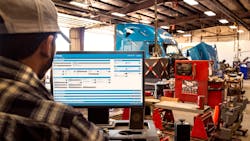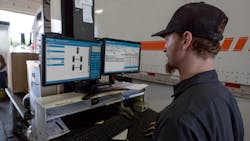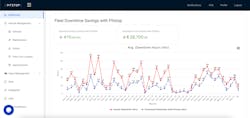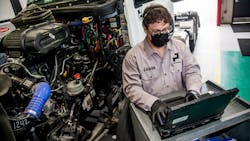Efficiency explodes with TMT (task management tools)
Efficient fleet maintenance operations today have multiple software options and methods to collect the data relevant to incoming jobs, such as vehicle identification numbers, driver complaints, and other necessary information as a vehicle enters the bay. That information is then compiled into the shop’s system, where technicians and maintenance managers can search for top fault codes and other problems at hand as well as delegate the right technician to perform the job. Broadly speaking, this software, known as task management tools (TMT), can be as simple as a spreadsheet—with smaller shops using Quick Books or Xcel—or take the form of a highly advanced platform using predictive analytics. The former can help you get you by, however, the latter can provide an explosion in efficiency.
These predictive technologies are being used to inform maintenance and repair departments about multiple issues that can be addressed in one shot rather than making the vehicle return to the service center several times over a two- or three-month period. They also inform maintenance departments about likely future problems, giving fleets a chance to schedule vehicle maintenance before a catastrophic event occurs.
Planning ahead
Shiva Bhardwaj, CEO of Pitstop Connect, a platform powered by artificial intelligence (AI) and machine learning (ML) to predict potential truck component failures weeks before they happen, emphasized that a fleet’s best bet is to use technology to plan downtime and minimize pain points related to unexpected downtime.
“Though fleet managers know they need data to make efficient predictive maintenance decisions, they fail to mine datasets to develop insights,” Bhardwaj said. “An effective fleet monitoring system leverages the power of AI, ML, cloud data storage technologies, and big data analytics to make accurate forecasts and assist technicians in identifying faults.”
Pitstop software, for instance, provides fleets with a vehicle health score, informing maintenance operations of the top 15 high-risk vehicles. “Those vehicles will continue to cause downtime,” Bhardwaj said, adding that the software generates reports that are automatically sent to partner service centers and drivers as needed.
Bhardwaj added this “lessens manual work and calculations, leaving little room for errors. No routine inspections are required since your [predictive maintenance] software has already conducted full diagnostics and shared the real-time vehicle health report with fleet managers.”Trimble Transportation offers a TMT software solution that provides communication between the driver and maintenance operation in real time as events happen on the road.
“By having that communication between the driver, the operation, and maintenance, we can increase our uptime, and planning and scheduling the work,” explained Renaldo Adler, head of software engineering, connected maintenance, Trimble Transportation. “If you look at predictive analytics and communicate that to operations, there is a probability we can schedule the truck.”
The same goes for an in-house repair, Adler said. Fleets can schedule a repair within Trimble’s software to ensure the truck gets fixed quicker.
“Operations can schedule it through our software, which has a tool that sends the mechanic the right information available to get that truck back on the road,” Adler said. He also stressed the need to know what parts and technicians are required to complete the job.
Another plus is that modern software can be wireless, allowing for over-the-air updates when a truck on the road requires an update or calibration of some sort, noted Willie Reeves, Paccar Leasing’s director of franchise maintenance.
“It can be done wirelessly instead of bringing the vehicle in or going to a customer’s yard and plugging in the laptop,” Reeves said. “It doesn’t interrupt a driver coming and going.”
Enabling communication
TMT software gives maintenance professionals the opportunity to check vital units and the overall health of fleet vehicles. Operations today are relying more on sensors to track a vehicle’s performance while it’s out on a trip to see if the unit is operating at normal range or outside of those normal parameters, Reeves pointed out.
And these systems are only going to keep advancing at a rapid pace. It wasn’t all that long ago when check engine lights and tire pressure monitoring systems were considered novelties. “Now, if we didn’t have those technologies, we’d be stuck on the road,” Reeves surmised.
“We are in such a microwave environment—everything has to be done instantly,” he added. “We need these technologies to communicate to the customer to let them know what’s going on ahead of time.”
To ensure trucks are running at peak performance, PacLease, which has a service provider network of more than 50,000 locations, has learned over the years how to best communicate potential problems with customers.
“Sometimes too much communication isn’t good, so being able to filter what communication is important to the fleet owners and operators is very important,” Reeves added.Driving the user experience
Communication and selecting the right tools for Houston-based Clark Freight Lines is incredibly important to president and co-owner Danny R. Schnautz. When it comes to technology and equipment integrations, Schnautz said he refuses to put “junk” in front of his drivers. As a former professional truck driver, he can spot junk when he sees it.
Over the years, that driver-focused mentality has made Clark Freight Lines particularly selective about the technology that its professional drivers and maintenance providers are asked to use.
The for-hire carrier runs a fleet of flatbeds, vans, specialized trailers, and a continuously expanding collection of intermodal chassis. The carrier hauls petrochemical products as well as imported lumber, plywood, stone, and other specialty cargo like warehouse materials, large statues, and even Grand Prix cars at one point.
Running that fleet is a mix of company drivers and owner-operators, many of whom have been with Clark Freight Lines for more than 20 years. Company co-owners Schnautz and his brother—also a former truck driver—have found that automating certain aspects of the business has been a major timesaver for everyone. Schnautz is quick to point out, however, that regardless of advancements in technology, the business won’t work without that irreplaceable human touch.
“Technology aids us; it doesn’t replace us,” Schnautz said. “Drivers are not interchangeable, and neither is our office staff. Using technology to complement their strengths and compensate for human weaknesses is the best place for the technology.”
To assist company employees, Clark Freight Lines, which has a management app of its own under development, relies on McLeod Software. Operational information is entered into McLeod’s system so all departments within the company know where vehicles are at any given time.
“We have an obligation to the drivers to deliver the best of what’s available—whether it’s the best run, the best days off, the best equipment, the best maintenance schedule, or the best trailer situation,” Schnautz said. “Whether a trailer is red-tagged or whether a run has increased in rate, we want to get that information in and share it with the driver.”
Fleets are also leveraging drivers’ electronic logging devices to view vehicle fault code information, although it’s not all that detailed, Pitstop’s Bhardwaj pointed out. A fleet of 100 vehicles, for instance, could have thousands of fault codes at any given time, he explained, making organizing important data that much more difficult.
Pitstop, which prioritizes fault codes by critical, major, and minor incidents, can show fleet maintenance providers an instance or description related to when an aftertreatment code comes up.The system then will link back to a diesel particulate filter, or highlight a problem with the nozzle or the diesel exhaust fluid system.
“Fault code data seems to be there for most fleets,” Bhardwaj explained. “It’s a matter of taking advantage of it, which not a lot of fleets are doing today.”
When it comes to mining for the relevant data to the fleet’s operations and duty cycles, Pitstop collects algorithms and a few hundred thousand assets that stream through its system. The platform analyzes historic patterns, like battery voltage over long periods of time for certain truck makes and models.
Pitstop platform users can then compare their vehicles to similar makes and models and better predict when a system might fail. “Then we can say this looks like a trending critical issue because it can lead to downtime,” Bhardwaj said.
“We try to learn from what has happened not just from that fleet, but for every fleet, and ensure that they have a better sense as a truck comes in,” he added.
Technician, parts management
Even the most organized fleet maintenance operations are struggling to get trucks up and running because of ongoing technician and parts and component shortages.
The U.S. Bureau of Labor Statistics reports some 28,100 openings for diesel technicians are projected each year, on average, over this decade. Inflationary pressures have also caused a spike in commercial vehicle equipment prices, with prices being passed down from suppliers to their fleet and dealer customers.
But this is temporary, Pitstop’s Bhardwaj said. When things smooth out a bit, he believes there will be a technological leap to help improve labor scheduling and maintenance management.
“You could probably plan 80% of the labor times more effectively,” Bhardwaj said, “because you have the data from the actual truck that’s coming in. Fleets can use it as a benchmark against how other people have done service. The technology can get us there, but I think it will take some time.”Future technician training will likely pivot as well, with less of an emphasis on training about what certain fault codes mean, and more around how to use software and when to make what decisions based on the data. The next step will be fitting the appropriate data into existing maintenance workflows.
“Then, things like ordering parts ahead of time and scheduling service with more accuracy ahead of time are the types of scenarios that get enabled once these solutions are adopted at a higher frequency,” Bhardwaj explained.
Ultimately, it will be about feeding back vital information to the fleet and the service center so all players can stay up to date on stock inventory, recalls, and warranty trends.
Trimble does something similar today through its integration with TravelCenters of America. If there is a condition on the road, Trimble can make a request from its software directly into TravelCenters of America’s system to inform maintenance operations when the driver will be in with the truck as well as the parts needed to turn that vehicle around quickly, Adler said.
Trimble also designed a tablet for technicians that tells them the trucks they need to work on, vehicle specs and history, and inventory needed from the parts department.
Adler explained the tablet has a common user interface to eliminate training, as technicians simply scan parts and key in numbers. The tablet also serves as a time clock for workers to manage their time throughout the day, and revisit how much time is spent on specific tasks, like changing tires and fixing brakes.
“Trucks are harder to fix now,” Adler said, noting technicians today need to be more tech-savvy and use more digital tools to fix a truck. “They need more electronic data. As it becomes a more technical job, hopefully it will bring more people into that field.”
One system PacLease is rolling out to help with the technician shortage is a voice-guided PM product to help train incoming technicians on how to perform preventive maintenance intervals. With voice-guided headsets, the system shows technicians how to start a PM and then has them follow modules online.
The system aims to standardize PMs for every PacLease location. “It also eliminates and removes someone from having to show someone else how to physically do a PM,” Reeves said. “With that, you gain that person working in the shop rather than as a PM trainer, and it opens that person up to do more scheduled maintenance.”
Speaking of PMs …
As part of its managed maintenance program for leased customers, PacLease schedules PMs and any repairs that need to be made so fleets don’t have to manage that themselves. Some of the biggest things Reeves sees from vehicles today are sensors going out and needed software updates.
“We really don’t see big mechanical issues happening on units,” he said. “It’s mostly the electronics. Those are the things we use to give us feedback on how the unit is performing.”
In today’s world with parts shortages, Reeves said PacLease is trying to be more proactive with its units, as it can take anywhere from a week to a month to procure a specific part.
Being proactive also means PM consistency. To keep things consistent, PacLease integrates with Kenworth’s TruckTech+ and Peterbilt’s SmartLINQ remote diagnostics and telematics solutions.
“Information goes back to the fleet manager, who is managing that crucial data, and it gives them the capability to check the units in their fleet,” Reeves pointed out. “If they have a fleet of 20 trucks, they can see how those 20 trucks are doing and compare the data between the trucks.
“It gives them the opportunity to move trucks around if they have a truck that is running high miles on their lease program,” he added. “They can move other trucks to that area to keep the mileage down.”
These days, Reeves is seeing more and more trucking companies leasing because of the rising price of commercial vehicle equipment. He added that because there are not that many trucks available in the market, companies also are holding onto their used assets versus turning them in—making PMs even more important.
“So, they might be running them for an extra year or two until they can get new vehicles in their fleet,” Reeves said. “They are working a little harder to make sure the maintenance on these units stays up to par.”
Fleets today are also battling rising diesel and oil prices, so managing idle time can be incredibly important for overall total cost of ownership. One of the parameters that fleet managers can view in their software is idle time, Reeves said.
“You can see how long a vehicle is idling throughout the day, and you can come up with best practices to help reduce the idle time,” he said. “Most of the idle time is done by percentages, so some units that are running regional might have a higher idle time than those running over the road. It gives managers the opportunity to decrease the idle time and keep the trucks from burning so much fuel.”
The electric future
As more commercial fleets begin the transition to electric powertrains, Trimble’s Adler noted that the job of a technician will become more challenging and require more safety precautions. At the same time, many in the industry anticipate that working on battery-electric vehicles and hydrogen fuel cells will be more appealing to the next generation of new talent.
The future, Adler noted, is also transitioning to a cloud infrastructure, where there is more data sharing and everyone in the industry will have the information to make better decisions and predictions.
“The OEMs are working on these too,” Adler explained. “They are modeling out repairs to make predictions of when parts are going to fail. They are looking at warranties. If we make a prediction and say this part will fail, it may not be covered under warranty from the OEM. So, there is this education element that needs to go on to verify the models are going to be correct.
“Analytics plays a big part and as we get to electric vehicles, more and more data will be coming off those electric vehicles,” Adler added.
PacLease’s Reeves also pointed out that electric vehicles will present new challenges for the technicians working on them, as these trucks will require different tooling, items of clothing, and training.
“I feel like technicians have a concern because they are dealing with electricity,” Reeves said. “There is always a concern when dealing with electricity, and how in-depth the transportation industry is going to go with electricity.
“Electricity is one component that you can’t make a mistake on because it will let you know that a mistake has been made,” he added. “A lot of components today are more electronically controlled than mechanically controlled. Vehicle electricity is more like the veins running through our body; doing damage to one can cause a big breakdown.”
Standardizing what wires to disconnect across the industry will also be necessary, Reeves pointed out. That has been top of mind for the technicians he works with.
Various unknowns still loom as the industry moves forward with commercial electric vehicles. But, as Reeves pointed out, everyone is on an equal playing field and learning at a pace that the industry can keep up with—for now.
Ways to use software
Pulling ELD data through a system like Pitstop’s organizes parts lists, so shops can instantly see if there are shortages on certain parts. Then, they can put in orders ahead of time, Shiva Bhardwaj, CEO of Pitstop, said. In addition, he said software can be used to:
- Optimize vehicle operations.
- Make data-based decisions.
- Track decays in fuel efficiency in real time.
- Review component wear rates.
- Focus on tracking all inputs that affect that vehicle.
About the Author

Cristina Commendatore
Cristina Commendatore is the Executive Editor of FleetOwner magazine. She has reported on the transportation industry since 2015, covering topics such as business operational challenges, driver and technician shortages, truck safety, and new vehicle technologies. She holds a master’s degree in journalism from Quinnipiac University in Hamden, Connecticut.




